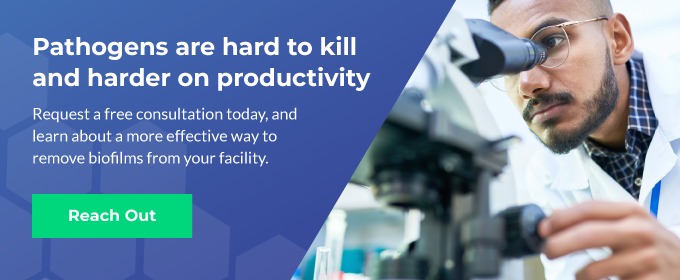The health risks associated with the most common foodborne pathogens are quite serious, and no company wants to be responsible for causing illness or death. When there is an outbreak of bacteria such as Salmonella, E. coli, or Listeria in a food processing facility, the financial implications can be disastrous for both consumers and food producers.
Product recalls, site decontamination, assembling a crisis team, and public relations are just a few of the direct expenses, not to mention the indirect costs of lost production and potential legal repercussions. When evaluating the expenses related to the prevention of bacterial contamination, the long-term brand damage is also an important consideration along with the exponentially higher cost of an outbreak.
In addition to the free-floating bacteria in facilities, bacterial biofilms are also a major challenge in the food processing industry. These colonies of bacteria are protected with an extracellular matrix, which makes them difficult to remove. In fact, most sanitizing chemicals require the use of mechanical action to effectively remove biofilms, which requires both extensive manpower and facility downtime.
This infographic from Decon7 highlights an alternative solution to daily sanitation, plant decontamination, and biofilm removal: D7. Learn more about the financial risks of bacterial contamination and how using D7 can help protect your valuable brand. See how it was developed, the chemistry behind it, application methods, and the many advantages of working with Decon7 for your plant sanitation needs. Find out how D7 can be incorporated into your sanitation protocols in food processing facilities and live production applications.

Decon7 is here to help you with bacteria removal and prevention strategies. Our team will work closely with you to determine the best approach to tackling an existing contamination issue—including persistent biofilms—and how to implement daily sanitation protocols that will help you avoid a problem in the first place. Request a consultation today to get started.

